lies like truth: December 2010 Archives
 The other day, I received a strange phone call from someone called Igor who works at the Russian Consulate of San Francisco.
The other day, I received a strange phone call from someone called Igor who works at the Russian Consulate of San Francisco.I had sent the consulate an email a few days previously to ask if the organization might be interested in supporting an upcoming episode of my weekly public radio show about singing on KALW, VoiceBox. The show in question is about Tuvan throat singing. I thought the consulate might consider underwriting the program. (Tuva is situated in the far south of Siberia and part of the Russian "empire.")
"We do not sponsor projects. We do not offer funding," Igor informed me on the phone.
"OK," I said, "Thanks for letting me know."
"But," Igor continued, "We can offer you moral support."
This last comment of Igor's was slightly baffling to me but I didn't want to seem impolite.
"Thank you," I said. "So what exactly does moral support from the Russian Consulate of San Francisco involve?"
"I don't know," Igor said. "Let me get back to you on that one."
A couple of days later, I received another phone call from Igor. He said he couldn't really think of any direct way in which the Russian Consulate of San Francisco could support VoiceBox in a moral way, but he wished me success.
Sweet.
When the program airs on January 21, I'm tempted to finish up the broadcast with the following words: "This episode of VoiceBox has been brought to you with the moral support of the Russian government."
P.S. I am skipping town for a while. I may blog while I'm away and I may not. I reserve the right to recommence operations on January 6 at the latest. Happy holidays!
 The San Francisco Art Commission's current playful outdoor art installation in the mid-Market area of downtown San Francisco demonstrates just how much people like to "publish" themselves. Faces, an interactive artwork by Theodore Watson projects enormous photographed portraits of passersby from The Warfield Theatre building (Market Street at Golden Gate/Taylor) onto a wall overlooking Market Street at 6th Street. Passersby stand in front of a "capture station" embedded in a wall at the Warfield, the image is snapped and seconds later it's "thrown" across the street to the top of another wall where it is visible to anyone walking away from the downtown area on Market Street.
The San Francisco Art Commission's current playful outdoor art installation in the mid-Market area of downtown San Francisco demonstrates just how much people like to "publish" themselves. Faces, an interactive artwork by Theodore Watson projects enormous photographed portraits of passersby from The Warfield Theatre building (Market Street at Golden Gate/Taylor) onto a wall overlooking Market Street at 6th Street. Passersby stand in front of a "capture station" embedded in a wall at the Warfield, the image is snapped and seconds later it's "thrown" across the street to the top of another wall where it is visible to anyone walking away from the downtown area on Market Street.The installation will be active for the next few months after nightfall (the hours are currently from 6.30pm-11pm). When I arrived on the scene at 6.30pm a couple of nights ago, people seemed completely transfixed by the installation. "I'm famous!" was the common cry as people saw their faces plastered on the wall across the street. Others who didn't stop to have their picture taken but noticed the changing images on the building, looked around to see where the source was and said things like, "wow, you're famous!"
Faces makes for a fun holiday / nighttime gimmick and brightens up a particularly drab section of Market Street that can definitely use more foot traffic and interesting eye candy. I also think that the big distance separating the individual standing infront of the Warfield having his or her picture taken and his or her larger-than-life projected image across the street speaks to the gulf separating a real experience from a mediated one. We might delight in seeing our projected faces, but within seconds the image is gone and reality smothers the narcissistic impulse associated with our "30 seconds of fame."
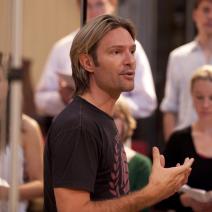 Gramophone Magazine's List of the Top 20 choral ensembles of the world is causing controversy because so many of the choirs that make the cut are British -- and all the top five are British choirs. None are American. The magazine defends itself in this interesting Q&A between Gramophone editor James Inverne and NPR writer Thomas Huizenga and published a sycophantic piece by choral composer Eric Whitacre (pictured) about why British choirs are the best in the world.
Gramophone Magazine's List of the Top 20 choral ensembles of the world is causing controversy because so many of the choirs that make the cut are British -- and all the top five are British choirs. None are American. The magazine defends itself in this interesting Q&A between Gramophone editor James Inverne and NPR writer Thomas Huizenga and published a sycophantic piece by choral composer Eric Whitacre (pictured) about why British choirs are the best in the world.Here's my two cents worth: Top 20 (or Top 10 or Top 100 or Top whatever) lists are very subjective and prone to biases of all kinds no matter how hard the producers of these lists try to be neutral (and most of them do not.) I don't think that the omission of American choirs from the list says that American choirs aren't worthy of a leading position on the world choral stage. It's more a reflection of the judges' predilections. What I find ludicrous is the idea, suggested by Inverne in the Q&A for NPR, that American choirs can't vary their dynamics as well as choirs of other nations. In any case, I'm hoping that the many fine choral ensembles in the US (e.g. LA Master Chorale, Chanticleer etc) take Gramophone's list with a pinch of salt.
Speaking of choirs, I've attended three choral concerts in the Bay Area in recent days and have comments to make about all of them specifically with regards to the use of space:
1. San Francisco Boys Choir "Bach to Broadway" concert at the Cathedral of Christ the Light, Oakland, Dec 18: I've seen several musical events at this venue since it opened a couple of years ago, including a performance by the superlative Chanticleer ensemble. It doesn't matter who's singing in the space and whether they're a cappella, accompanied by the organ or piano, or have a full-on rock band backing them up -- the acoustics suck. I've mentioned the cathedral's sound problem in this blog before but felt that maybe I hadn't experienced the space enough times to make a fair judgment. I think that now, having heard the boys' voices gobbled up to the point of unintelligibility, I can definitively say that the space is not fit for vocal music performances of any kind. The Cathedral should hire Meyer Sound or some other top sound firm to sort out the grave acoustical issues, or sooner or later the novelty of performing in the space will wear off for singers and there'll be no music worth listening to at the cathedral.
2. "A Chanticleer Christmas" at St. Ignatius Church, San Francisco, Dec 19: The ensemble spent most of the second half of its concert wandering around the enormous church. I am in two minds about this activity. On the positive side, the choir's perambulations meant that you didn't have to be sitting in the middle near the front to get a close-up view of the singers. The walk-through brought them close to lots of audience members, thus creating a more intimate experience for everyone. On the negative side, the fact that most of the audience couldn't see the choir for long periods of time during their walkabout meant that lots of heads got buried in programs. People seemed to get a bit bored with not having singers to look at and decided to read instead, which was a shame considering the beauty of the music. P.S. the concert highlight for me was alto Adam Ward's amazing solo in Steven Sametz's "Two Medieval Lyrics."
3. Ave's "Christmas Around the World" concert at St. Mark's Episcopal Church, Berkeley, Dec 20: The small ensemble led by Jonathan Dimmock sang an unusual shape-note-style version of "While Shepherds watched their Flocks" arranged by Mark Winges with the choir split up into two groups -- one at the back of the church and one at the front. I didn't understand the point of creating this setup when the piece doesn't seem to require it. There's nothing antiphonal about it. Slightly gimmicky. The sound the singers produced was lovely and warm throughout the concert though.
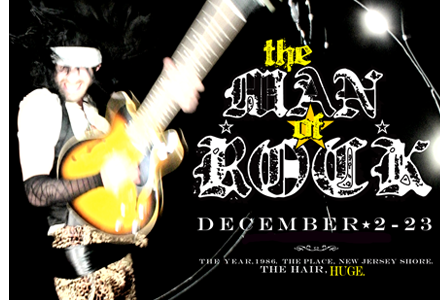 It's always a great solace to me as a non-believer, that the Bay Area offers so many interesting forms of non-traditional cultural fare during the holiday season.
It's always a great solace to me as a non-believer, that the Bay Area offers so many interesting forms of non-traditional cultural fare during the holiday season.For instance, one of the highlights for me personally last year was finally making it over to Berkeley's Cal Performances to catch the Mark Morris Dance Company's irreverent take on The Nutcracker, The Hard Nut.
This year, I've moved from hard nut to hard rock, as the best thing I've experienced so far has been a musical by The Climate Theater, a small local theatre company, entitled The Man of Rock. A world premiere written by Daniel Heath with music by Ken Flagg based on George Etherege's 17th century comedy of mannersThe Man of Mode, The Man of Rock is rather atypical for a holiday season show in that it has nothing to do with Christmas or any other festival. It's a musical adaptation set in the rock music world of 1980s New Jersey. What makes The Man of Rock great holiday fare (or indeed great fare for any time of year really) is that it's quite clever and completely entertaining.
Despite a couple of transition / timing issues between beats, a slightly flat performance by one actor (alas he plays the main character but somehow I didn't seem to mind him being upstaged by the other talented cast members who fully embody their roles) and some glam rock music schtick like jumping up and down from the speaker during the musical numbers which gets a bit boring through endless repetition, the production makes for a lively way to spend a couple of hours on a dank night.
If you're sick of choral concerts and drag acts and happen to be in the Bay Area this week, head over to the Jewish Theatre to see the show in its closing performances. It runs till Dec 23.
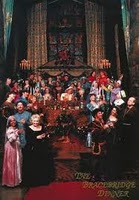 A couple of musings about vocal music for the start of the week.
A couple of musings about vocal music for the start of the week.1. A few days spent in Yosemite last week took me to the Bracebridge Dinner for the second time and, for the first time, to a concert of yuletide vocal music performed by the Andrea Fulton Chorale, the group that provides the entertainment at the Bracebridge Dinner. My impressions of the Dinner haven't changed much since I wrote about it last year on this blog and a couple of months ago for American Theatre Magazine, so I won't add anything new except to say that the production is virtually the same from year to year and the best way to have a different experience of it is to sit in a different part of the Ahwahnee Hotel's grand dining hall. The view from by the aisle, which is where I sat this time around was much better than last year, where I was close to the stage, but to one side. Being in the middle this time felt more festive and intimate because I got a perfect view of the performers as they traipsed up and down the aisle. The free Pops concert, which the Bracebridge performers gave the night after I attended the Dinner, was great in a way because it demonstrated the considerable talent of the individual performers involved in the yuletide festivities at the Ahwahnee, something that the Dinner doesn't really achieve except in the case of a few major performers. In fact, the solo and small group performances in the Pops concert were much stronger than the choral pieces because the singers that Andrea Fulton (who directs the Bracebridge Dinner and related events) picks seem to be more geared towards solo careers than happy singing as part of a large group. As a result, there were a lot of warbly, vibrato-heavy voices sticking out of the texture in many of the choral numbers on the program. I wonder whether Andrea Fulton would be better served by picking mostly choral singers for the Bracebridge Dinner with only one or two strong solo voices in the mix?
2. I finally got around to watching Never Stop Singing, a new documentary about the Minnesota choral singing scene, which the producer sent in the mail a while ago. If you sing in a chorus in Minnesota, you will no doubt find the documentary deeply fascinating. But unlike the choral music film Young @ Heart, which appeals to a broad audience because of its humorous and slightly detached / journalistic slant, Never Stop Singing couldn't be more dull for anyone who isn't part of the MN scene. The film devotes way too much time to talking about what makes MN such a happy place for choral singing and doesn't make any attempt to engage with the subject in an analytical way. It's largely a case of repetitive back-slapping and self-congratulation. Still, the documentary does provide a great overview of many of the different MN groups and composers as well as a potted history of the development of choral music in the area, which is mildly interesting for a vocal music wonk like myself. I'm going to give my copy to the San Francisco Public Library as I promised the producer. I wonder how many people here in the Bay Area will rent it?
 A fab weekend of eclectic arts activities to summarize today...
A fab weekend of eclectic arts activities to summarize today...1. Cutting Ball Theatre's production of The Tempest: Rob Melrose is one of the Bay Area's more thoughtful and creative directors, but on occasion he overthinks things. This is the case with his production of Shakespeare's magical late play, The Tempest. The director tries to impose an uber-Jungian reading on the fantasy which destroys all the magic. The central conceit is that the entire play takes place in Prospero's head, with all the characters being embodied by three actors. The cast members do as best as they can to make the quick switches between parts (a very demanding proposition) but the conceit quickly becomes lifeless and heavy-handed.
2. Train exhibition at the Conservatory of Flowers: The Conservatory of Flowers in Golden Gate Park has a charming temporary exhibit featuring a model train running through a winsome urban landscape whose buildings - all San Francisco landmarks such as the Golden Gate Bridge, the Trans America Pyramid and the Ferry Building - are fashioned from everyday odds and ends like forks, corks and keys from computer keyboards. Watching the train chug by while enjoying the gorgeous detail of the installation is a lovely way to spend some time. The exhibit also makes for an interesting contrast to the hothouse next door with its dripping ferns and fat lilly pads. Both the train exhibit and the plant halls communicate a sense of abundance and inspire the imagination while suggesting a quirky symbiosis between the natural and man made worlds.
3. Holiday ice dance show at the Yerba Buena Ice Skating & Bowling Center: The ice-rink at Yerba Buena Gardens is one of San Francisco's best-kept secrets. People flock to the open-air ice-rinks at the Embarcadero and Union Square, but the city's lovely permanent rink (where the Olympic gold medallist Brian Boitano regularly hones his skills) often gets passed over. Yet for locals who take ice skating seriously (or at least think of it as a real hobby rather than a once-a-year, post office-holiday-party fling on one-too-many eggnogs) the rink is a bustling home. The Christmas show, based on a "Dancing with the Stars" theme, displayed the ice skating center's range of skill-levels. There were tiny children in purple spangly outfits skittering on the ice like baby penguins taking their first steps, pros-in-the-making doing flawless pirouettes and triple lutzes and adult amateurs linking hands and skating in careful formation. The music erred on the cheesy side (think Whitney Houston, Lionel Richie, Elton John etc), the costumes sparkled and the thick makeup made even the five year olds look like drag queens. The tackiness seemed to work well with the happy, holiday vibe of the event. I was excited by the amount of talent on the ice as well as the broad-based community feeling of the show.
Oh, and I'm skipping town for a few days. Lies Like Truth will be back on Friday or next week...
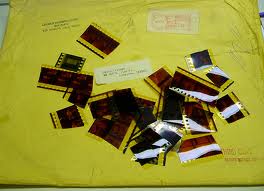 It's a sad but all too common thing when an artist shares their experiences with a journalist for an article and then their comments don't actually make it into the published story.
It's a sad but all too common thing when an artist shares their experiences with a journalist for an article and then their comments don't actually make it into the published story.Most interviewees understand that journalists do a lot more reporting than can possibly be used in the average piece. But sometimes they don't get it and you feel just awful about it.
I felt particularly bad about a source that got omitted from the article I wrote for today's New York Times about Bay Area string quartets. I interviewed many people for the story and much of the input ended not even making it into the article. But this one very quirky and under-the-radar string quartet, where the musicians combine playing their instruments with singing, was supposed to get a mention. For space reasons beyond my control, the lines I devoted to talking about this group ended up on the cutting room floor.
I did something I don't usually do: I wrote to the interviewee yesterday afternoon after I saw the final edit to tell her that her ensemble wouldn't be appearing in the paper. I don't know what compelled me to contact the interviewee -- after all, I didn't email at least half a dozen other sources to tell them the same thing. I think it was just something to do with the fact that we connected on the phone so well and that I am very interested in the group's approach to string quartetting, being a singer and the host of a radio show about the vocal arts (VoiceBox on KALW). Plus, this quartet doesn't have the same visibility as some of the other ensembles that did make the final cut. So I wanted to temper her expectations and apologize for the editors' decision.
My source's disappointment was palpable. She bemoaned being "the one group that always gets left out" and i had to write to tell her that many sources got left out. Sigh.
Interviewees need to understand that talking to a journalist is just one step in the process. The moral of the story: It's wisest not to send out an email to your entire network telling people you're going to be appearing in the New York Times until the article actually comes out.
 As someone who started a non-profit a year ago and recently mounted her first fundraiser, it's always fascinating to me to see how the big guns go about their fundraising event efforts.
As someone who started a non-profit a year ago and recently mounted her first fundraiser, it's always fascinating to me to see how the big guns go about their fundraising event efforts.Last night, the University of California at San Francisco mounted something approaching the mother of all benefits at the Masonic Temple on Nob Hill. The evening's proceedings included solo performances by Neil Young and Joanna Newsom, an introductory address by Colin Powell and copious amounts of truly delicious food and wine. Even the statutory silent auction was a cut above with prizes like an electric guitar autographed by Neil Young.
In short, the event, which raised several million dollars just in ticket sales to help fund a new children's hospital at UCSF, was a far cry from my little soiree for VoiceBox the other day.
Although the UCSF event was successful from a fundraising and culinary perspective Powell did a rousing job with his heartfelt speech, I was slightly disappointed with the high-powered arts offerings of the benefit.
Joanna Newsom's songs were unbelievably long considering most of them only use two chords. Her voice has a raspy, tremulous and babyish quality so it was impossible to make out a single word she was singing while she plucked and slapped away at her harp. I dunno. Newsom's hipster-mistrel-pixie shtick gets old very quickly.
Neil Young's set wasn't all that inspiring either. The rock legend mainly rambled about the stage playing a series of guitars, each one more dirty-sounding than the previous one. He played a few standards (e.g. "Helpless") and some soapbox-standing newer tracks about the ills of war and so on. Towards the end, Young sat at two different pianos to perform two different tracks. I couldn't understand why he needed so many instruments about him -- surely one guitar and one piano would have done just as well? For my part, I couldn't really detect a great difference in timbre between the shabby-looking upright and the magenta-colored baby grand (which the artist said his daughter had painted.) And as for the guitars, I would have preferred a classic acoustic set from the great man. At one point, Young even went up to a small pipe organ on stage which he had brought in for the show. But instead of playing it, he told a story about how the instrument got damaged in a fire rescue operation and was now unplayable. I wonder, was this supposed to be a bit of performance art? Maybe the damaged organ was supposed to represent one of the sick children at the UCSF hospital? Still, one thing that can be said about Young is that he has brilliant diction. Even from way up in the balcony where I was sitting, I could every word the artist sang came across crystal clear. Joanna Newsom could learn a thing or two from her elder.
No one seemed to mind the iffy quality of the entertainment though. I guess Young could sneeze and he'd get a round of applause and shouts of "We Love You Neil!!!" from the back of the 2,000-seat auditorium. And it also amazes me that Newsom can hold so many people in thrall with her (pretty mediocre) harp playing and singing.
I suppose there's a always a feel-good element to a fundraiser: People want the project they're sponsoring to succeed so they're overwhelmingly positive even in the face of mediocrity. This is a good thing if it means that children's hospitals get built as a result.
 I just ran into the opera director Francesca Zambello in Arlequin, the lovely cafe on Hayes Street in San Francisco which practically serves as my office. "Why isn't there a place like this in New York?" Zambello, who lives on the East Coast but is here on San Francisco Opera business, said.
I just ran into the opera director Francesca Zambello in Arlequin, the lovely cafe on Hayes Street in San Francisco which practically serves as my office. "Why isn't there a place like this in New York?" Zambello, who lives on the East Coast but is here on San Francisco Opera business, said.I'm sure there must be places like Arlequin in New York, but it's true that if you're a culture industry worker in San Francisco, Arlequin is the place to be.
On the average morning while sipping my coffee, checking my email and writing my daily blog post for ArtsJournal, I spy any number of arts personnel here. In the past hour or so I've seen Zambello; the Pulitzer Prize winning writer James B Stewart (who's working with Zambello on the Heart of a Soldier world premiere at SF Opera); the opera's music director, Nicola Luisotti, and his wife; Christine Bullin, the executive director of Chanticleer; several San Francisco Symphony staffers and musicians; two members of the San Francisco Boys Chorus with their doting parents; the founders of an arts PR company; five San Francisco Ballet dancers (admittedly, this is a guess - they all look like ballet dancers and I know for a fact that one of the cluster is with the company); and Sydney Goldstein, who runs City Arts & Lectures (my coffee date this morning.)
I love this place.
 Watched an extraordinary and highly improbable five-minute animated film on YouTube yesterday which succinctly captures the disjunct between the non-profit arts funding model and the general public's understanding of the economics involved in creating non-commerical art in this country.
Watched an extraordinary and highly improbable five-minute animated film on YouTube yesterday which succinctly captures the disjunct between the non-profit arts funding model and the general public's understanding of the economics involved in creating non-commerical art in this country.I say "improbable" because the tongue-in-cheek film, entitled "Explaining an Arts NonProfit," takes the form of a conversation between two saccharine-cute, tubby, panda-bear-like characters with tinny computer-processed voices. It sounds like an exchange out of a Level 1 foreign language textbook as delivered by HAL or two of Dr. Who's Daleks and looks like a Japanese children's TV show.
One character, the leader of a small, professional vocal ensemble, politely hits all of the vacuous "mission statement"-type ideas that art makers put into their funding proposals in order to get funding or use to talk to other constituents in order to solicit private donations. The other character, an audience member who loves the ensemble's music but doesn't understand why he can't get free concert tickets, responds to all of the choral directors assertions about "tax-deductible donations" and "CD sales don't make as much money as the cost of producing the CDs" with completely reasonable yet somehow outrageous statements like "that sounds like bad business practice."
In short, the two characters, though they try to see eye to eye and are stiffly polite to each other throughout the conversation, are at a complete impasse.
Click here to view the film.
 A weekend of dazzling indoor performance and drizzly outdoor community engagement. Fun.
A weekend of dazzling indoor performance and drizzly outdoor community engagement. Fun.1. Volunteer planting day in The Presidio: Stumbled across this wonderful event led by the Presidio Trust while out on a random walk in the rain which up to that point had involved walking all over Andy Goldsworthy's newly installed eucalyptus tree installation, Wood Line, near the Presidio Gate (the wooden beams were slippery, but I trod the entire thing without once falling off.) Joined about 60 other volunteers (most of whom had planned to be there unlike me) in planting an area of rich, soft soil with thousands of new plants from the park's nursery. The Trust provided breakfast and lunch (though I didn't stay for the latter), all the necessary wet weather gear and tools, as well as special tours of local historical and archeological interest points. A park historian was on hand to share information. I plan on volunteering again as soon as I can. It's a great way to learn about local history and culture, make new friends and do some good for the environment and community.
2. El Nino at San Francisco Symphony: My head is still full of the beautiful, eerie final scene from John Adams' oratorio, which retells the nativity story with a Latin slant. The composer was on the podium, waving his baton in a jerkily energetic manner that belied the onrushing, seamless warmth of his music. Soprano Dawn Upshaw and bass-baritone Jonathan Lemalu looked like a couple of truck drivers in the shapeless contemporary attire that they had been put in for their roles as Mary and Joseph. Lemalu sounded solid, but Upshaw's voice seemed breathy at times. Countertenors Daniel Bubeck, Brian Cummings and Steven Rickards, dressed in modish white outfits, made for a dazzling trio of angels (collectively playing Gabriel) with their curlicue lines and gliding way of walking across the space during the semi-staged performance. The San Francisco Symphony Chorus spun a blazon of sound and the San Francisco Girls' Chorus added an unbearable sweetness to the aforementioned final scene, creating a memorable tableau around the central characters. Adams' instrumental music usually inspires me, but I've been generally less taken with his writing for voices thus far. Experiencing El Nino live has given me a new appreciation for the composer's understanding of the vocal arts.
3. Elza Van Den Heever recital for San Francisco Performances at The Conservatory of Music: Here's a singer I'm going to keep a close eye on. The South African soprano has been kicking about The Bay Area lately with gigs at the SF Symphony and Salle Pianos to name but two. A friend of mine who saw her performance at Salle the other day said she made him cry. It's easy to see why: Van Den Heever embodies the emotion of her music so dramatically that it would take a heart of stone not to feel viscerally moved while she sings. Van Den Heever's heart clearly lies with Romantic music. Her renditions of Schumann lieder were particularly affecting as were her explorations of Strauss, thanks to a warmth of tone, perfect diction and strong emotional delivery. I wouldn't travel far to hear Van Den Heever's Baroque interpretations though.
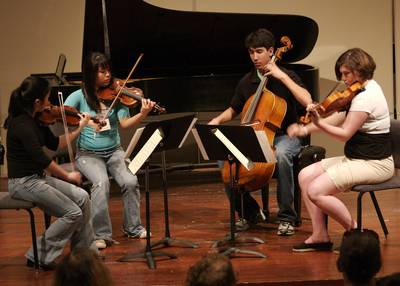 These days, with string quartets playing Jimi Hendrix and clarinet quintets playing latin jazz, the definition of what constitutes chamber music is becoming blurred. I got into this today during an interesting conversation with Susan Bates, a long-time string player in the Bay Area and board member of the local service and grant-making organization, San Francisco Friends of Chamber Music (SFFCM).
These days, with string quartets playing Jimi Hendrix and clarinet quintets playing latin jazz, the definition of what constitutes chamber music is becoming blurred. I got into this today during an interesting conversation with Susan Bates, a long-time string player in the Bay Area and board member of the local service and grant-making organization, San Francisco Friends of Chamber Music (SFFCM).SFFCM defines chamber music as: "music performed by two or more players, with one player per part and no conductor."
Hearing this definition, and given our conversation about crossover groups like Quartet San Francisco and the Turtle Island Quartet that use the string quartet format to bring jazz, folk, latin, rock and other formats to concert halls normally reserved for the playing of quartets by Haydn, Mozart and Beethoven, I asked Susan: "Does this mean that a rock group, which has two or more members, each playing one to a part and no conductor, would also be eligible for a grant from SFFCM?"
Susan admitted that the definition of chamber music is a moving target and that SFFCM is constantly updating its ideas on what constitutes the art form in today's world. But it seems that rock groups, despite meeting the criteria for defining chamber music as set out by SFFCM, wouldn't really be eligible to become a member of the organization or apply for funding from it.
Here's what Susan said by way of explanation:
"We have not had rock groups approach us. What we feel we're looking for is not traditional in genre, but traditional in terms of the everyday life of a chamber musician. This means consistent membership and a lot of rehearsing. You could say that of a rock group of course. It's an ongoing discussion. We have nothing against rock music. But we're here to help classical musicians where assistance and financial backing are not so readily present. We also want to preserve an art form that comes from the world of classical music, though we also support early music, jazz and cross-genre ensembles. It's hard to draw a line. We're there to assist the best quality artists we can who don't necessarily have much visibility with the general public. Our mission is to keep vital the art form. But as the art form changes, the definition may change too."
I wonder what would happen if a Bay Area rock band were to apply to SFFCM??
 For many artists, "nationalism," is a pejorative term. But need it be?
For many artists, "nationalism," is a pejorative term. But need it be?I got onto the wrong side of a wonderful Mexican composer today by wanting to talk about the nationalistic aspect of some of his work. By his own admission, the pieces we discussed are inspired by Mexican cultural pride. His works contrast wildly from that of the Nationalism-With-A- Capital-N of pieces by the likes of Revueltas, Ponce and Chavez. They celebrate Mexico in a different way, with a sense of humor and a unique musical language. There's no confusing my composer friend's nationalistic works with the Nationalistic ones of the composer's forebears.
And yet the N word seems to stick in his craw.
I don't see why that should be the case. People take from his music what they will. Knowing that it is inspired by the culture and heritage of Mexico creates a gleaming prism through which to understand the work more deeply. That's all. It's nothing to be ashamed of.

I was on the phone yesterday with violinist David Balakrishnan, the founder of the Turtle Island String Quartet. One of the most memorable things he said in a conversation that spiraled all over the place was about the relationship between classical music and meditation in western culture.
"I think of classical music as being equivalent to the meditative side of western culture," David said. "You go go to a concert, sit quietly, get inside yourself, stay with the music and be present with it. I don't think enough can be said about this in a bustling world of short attention spans. And, yet we're so drawn to the east for meditation. Why is this when we have our own form of meditation in the form of classical music?"
What David says isn't rocket science. It's simple and blindingly obvious, really. But I'd never really thought of classical music in that way before.
Of course, not all classical music makes you want to connect with your inner Buddha. I don't think Stravinsky's Sacre du Printemps or Wagner's Meistersinger could really be thought of as meditative in the traditional sense.
But as classical music organizations become increasingly obsessed with providing "experiences" for audiences that overstimulate all the senses in an attempt to stop people from "getting bored", they should remember David's words. There's nothing wrong, especially in these hectic times, with being as still as a yogi in a concert hall and letting the music wash over you like a mantra. Maybe if people increasingly started thinking of classical music concerts as meditation, concert hall music could truly complement yoga as a means to quiet the mind and breathe deeply in the western world. Or, at the very least, concert halls would sell more tickets and there'd be space in my oversubscribed yoga class for a few extra mats.
"I think of classical music as being equivalent to the meditative side of western culture," David said. "You go go to a concert, sit quietly, get inside yourself, stay with the music and be present with it. I don't think enough can be said about this in a bustling world of short attention spans. And, yet we're so drawn to the east for meditation. Why is this when we have our own form of meditation in the form of classical music?"
What David says isn't rocket science. It's simple and blindingly obvious, really. But I'd never really thought of classical music in that way before.
Of course, not all classical music makes you want to connect with your inner Buddha. I don't think Stravinsky's Sacre du Printemps or Wagner's Meistersinger could really be thought of as meditative in the traditional sense.
But as classical music organizations become increasingly obsessed with providing "experiences" for audiences that overstimulate all the senses in an attempt to stop people from "getting bored", they should remember David's words. There's nothing wrong, especially in these hectic times, with being as still as a yogi in a concert hall and letting the music wash over you like a mantra. Maybe if people increasingly started thinking of classical music concerts as meditation, concert hall music could truly complement yoga as a means to quiet the mind and breathe deeply in the western world. Or, at the very least, concert halls would sell more tickets and there'd be space in my oversubscribed yoga class for a few extra mats.
